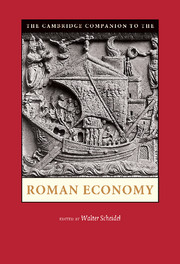Book contents
5 - Slavery
from Part II - Labor
Published online by Cambridge University Press: 05 February 2013
Summary
Building on Greek and Hellenistic institutions, ancient Rome created the largest slave society in history. There are several reasons for defining the Roman Empire as a slave society, above all in its Italian core but also to varying degrees in its subject territories. Slaves, numbering in the millions and widely dispersed, accounted for a non-trivial share of its total population. In key areas, slaves were not merely present but supported what has been termed a ‘slave mode of production,’ a mode that rested both on an integrated system of enslavement, slave trade, and slave employment in production, and on “the systematic subjection of slaves to the control of their masters in the process of production and reproduction.” Most importantly, Rome counts as a slave society in terms of the structural location of slavery: dominant groups, once again above all at the core, relied to a significant degree on slave labor to generate surplus and maintain their position of dominance. Since the role of slavery in central productive processes turned Rome into a ‘slave economy,’ just as the widespread domination of slaves as a primary social relationship made it a ‘slave society,’ these two terms may be used interchangeably, especially in those strata where slaves and ex-slaves continuously enveloped owners and patrons and mediated their interaction with the freeborn population. In short, Rome was a ‘slave society’ to the extent that without slavery it would have looked profoundly different.
In keeping with the theme of this volume, this chapter focuses on the economic dimension of Roman slavery. It addresses the three principal questions of ‘what,’ ‘why,’ and ‘how.’ What was the Roman slave economy like – what did slaves do, where, and for whom? How many were there and where did they come from? And how did Roman slavery compare to other major slave systems in world history? Why did Romans employ slave labor the way they did? How did the Roman slave system develop over time? The overall objective is to assess the economic importance and consequences of Roman slavery, its contribution to the formation of the Roman economy as a distinctively imperial system of domination, production, and exchange.
- Type
- Chapter
- Information
- The Cambridge Companion to the Roman Economy , pp. 89 - 113Publisher: Cambridge University PressPrint publication year: 2012
- 26
- Cited by



